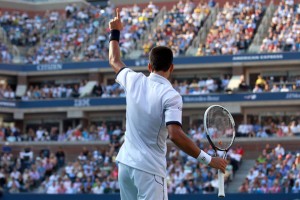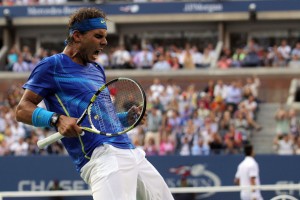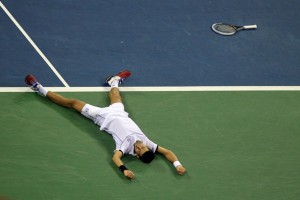US Open, Final
(1) Djokovic d. (2) Nadal, 6/2 6/4 6/7 6/1
When Rafael Nadal opened today’s US Open final by breaking Novak Djokovic with the utmost belligerence and moving to a two games to nothing lead, the writing was on the wall: ‘Yo te aplastará!’ it proclaimed. You will be crushed! Sadly, Djokovic commands little Spanish, and was thus less intimidated than he might have been had his command of that fine tongue been more accomplished.  Ignorant of the peril he was apparently in, the top seed went on to claim the next six games, sealing the first set in a touch over three hours.
Ignorant of the peril he was apparently in, the top seed went on to claim the next six games, sealing the first set in a touch over three hours.
Incensed that his warning had gone unheeded – and uncomprehended – in the first set, Nadal ominously repeated himself at the commencement of the second. Again he moved to a two game lead. Once more the message was clear: ‘Upon subsequent consideration, now I will crush you!’ For no clear reason, it was now scrawled in Catalan, and so Djokovic was again less cowed than perplexed. He shook his head, set to work, and only four hours later, claimed the second set. There was a lot of running.
Vague and poly-linguistic threats aside, the pattern of those opening sets was clear, and clearly revealed that for all Nadal’s recent chatter about working out how to play Djokovic, he hasn’t come up with anything useful yet. Hopefully ‘serve poorly’ wasn’t his new secret weapon, although who is to say, given that his strategy back in Rome featured ‘junk-balls to the service line’, guaranteeing a broadly similar result. Most notable today was Nadal’s unwillingness to occupy his backhand corner, usually a second-home. How many times in the last seven years have we watched him dance nimbly around to unload on his forehand, inside out and in?  The issue for Nadal is that doing so opens up his forehand corner, and that unless his forehand is a monster, Djokovic will probably reach the ball, and, remaining balanced even at the uttermost stretch, launch it into the open court. Thus constrained, Nadal remained shackled to the centre of the baseline, which inevitably brought his far weaker backhand into play. Djokovic saw to that. For all that their rallies – their endless, impossibly physical and brilliant rallies – varied considerably from point to point, each at its core had Nadal fending the Serbian off his backhand. (For a fan of Roger Federer, there was doubtless an almost karmic satisfaction to be gained from watching it unfold this way.) It revealed just how little control Nadal has over the depth on his two-hander, and just how his slice, even at its best, does little more than neutralise the opponent. For great swathes of the match, the Spaniard’s forehand – among the most feared in the sport – was only brought into play if and when Djokovic chose to.
The issue for Nadal is that doing so opens up his forehand corner, and that unless his forehand is a monster, Djokovic will probably reach the ball, and, remaining balanced even at the uttermost stretch, launch it into the open court. Thus constrained, Nadal remained shackled to the centre of the baseline, which inevitably brought his far weaker backhand into play. Djokovic saw to that. For all that their rallies – their endless, impossibly physical and brilliant rallies – varied considerably from point to point, each at its core had Nadal fending the Serbian off his backhand. (For a fan of Roger Federer, there was doubtless an almost karmic satisfaction to be gained from watching it unfold this way.) It revealed just how little control Nadal has over the depth on his two-hander, and just how his slice, even at its best, does little more than neutralise the opponent. For great swathes of the match, the Spaniard’s forehand – among the most feared in the sport – was only brought into play if and when Djokovic chose to.
The integrity of these patterns began to collapse in the third set, largely because Nadal saw how irretrievably proceedings were heading south. Compelled to change things up, he changed them up. True, he didn’t start serve-volleying – to do would have been equivalent to requesting Djokovic stop beating him with the butt of his rifle, and just shoot him – but he did grow more daring. Caution was hurled windward, and Nadal set out to dictate the points. It was a vast effort, among the most exacting and courageous I have seen from this most courageous of players, and all it allowed him to do was level-peg with the world No.1. Then, at 5/5, Djokovic broke anyway, and after only 12 hours of play, he stepped up to serve for the most meandering of straight sets victories.  To his credit, Nadal sustained his attack. Djokovic tightened, the Spaniard broke back, and they moved to a tiebreak. The crowd were deafening, and Nadal was suddenly untouchable. Suddenly all the forehands were monsters, and he romped to the set.
To his credit, Nadal sustained his attack. Djokovic tightened, the Spaniard broke back, and they moved to a tiebreak. The crowd were deafening, and Nadal was suddenly untouchable. Suddenly all the forehands were monsters, and he romped to the set.
The fourth set was a strange affair . . . but not really. Constrained by a slightly-tweaked back, Djokovic began to attack everything. The first few sets had been savage, but the physicality had owed a lot to the native caution of the players. Now, finally driven to it, Djokovic was actually playing hardcourt tennis, flattening out his drives and aiming for the lines. Nadal, spent from his earlier toil, was no longer fast enough. The final set blowout is not an unusual phenomenon in best of five matches. (It felt very much like the French Open final, when Federer grew unplayable in taking the third set, only to muster little resistance in the fourth.) After 19 straight hours on court, the writing was on the wall once more, but this time it was in English, and plain for all to see: ‘The end is nigh.’ Nadal was done, and Djokovic had done the unthinkable.
Novak Djokovic now holds the Australian Open, Wimbledon and US Open titles, and was only a couple of matches from taking the French. He has also claimed five Masters titles, and a few others. He has lost two matches for the year, one a retirement. He is approximately a million points clear of the field at No.1, and can longer be stopped from finishing the year in that position, even if he doesn’t hit another ball. He has defeated Nadal and Federer a combined ten times for the year, and today became just the second man to beat both in a single major. Surely, the Fedal Era is over. Some might wonder if the Djokovic Era has truly begun, but, really we should more usefully ask how it might possibly end.

One Response to Never In Doubt